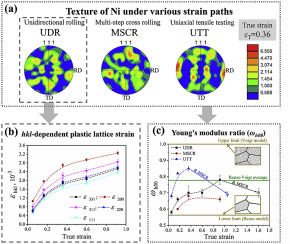当前位置:
X-MOL 学术
›
Int. J. Plasticity
›
论文详情
Our official English website, www.x-mol.net, welcomes your
feedback! (Note: you will need to create a separate account there.)
A new diffraction line profile breadth analysis approach for evaluating plastic lattice strain anisotropy in cold-worked nickel under various strain paths
International Journal of Plasticity ( IF 9.4 ) Pub Date : 2019-01-01 , DOI: 10.1016/j.ijplas.2018.08.006 Fulin Jiang , Takuro Masumura , Kentaro Hirata , Toshihiro Tsuchiyama , Setsuo Takaki
International Journal of Plasticity ( IF 9.4 ) Pub Date : 2019-01-01 , DOI: 10.1016/j.ijplas.2018.08.006 Fulin Jiang , Takuro Masumura , Kentaro Hirata , Toshihiro Tsuchiyama , Setsuo Takaki

|
Abstract Plastic lattice strain anisotropy in polycrystalline aggregates involves complicated integration of single crystal elastic anisotropy, grain-grain interactions and orientation-dependent slip activations. It is essential to experimentally determine plastic lattice strain anisotropy for in-depth understanding elasto-plastic deformation mechanisms and rationalizing advanced models. Unlike the widely applied method for quantifying elastic lattice strain anisotropy utilizing diffraction peak shift, accurately evaluating plastic lattice strain anisotropy is still enormously challenging over the decades. In this work, we developed a new diffraction line profile breadth analysis approach to reliably assessing plastic lattice strain anisotropy based on the simple linear dependence in quasi elasto-plastic model. The approach is confirmed to be effective and adaptive in practical application by linearization of the experimental dependences for line profile broadening in nickel under various cold-working strain paths. Then the orientation-dependent plastic lattice strain values could be reliably estimated up to high strain levels, which were identical to the magnitude of published elastic lattice strain. The strain levels and strain paths dependent plastic anisotropy magnitude was also inferred and further compared with the results from classical elastic models, i.e., Reuss, Voigt, Reuss-Voigt average and Eshelby-Kroner models. Simultaneously, by further carrying out microstructural characterization and dislocation model based line profile analysis, correlative texture and dislocation (arrangement and edge/screw constituent) developments were found to be strongly depended on strain paths, as well as verified to be the primary contributions to strain anisotropy. In addition to the proposed explanations in two-phase composite model, the strain hardening was demonstrated to be impacted by strain anisotropy behaviors as well. The fundamental mechanisms and significance of above interrelated effects under various strain paths were also well discussed.
中文翻译:

一种新的衍射线轮廓宽度分析方法,用于评估各种应变路径下冷加工镍的塑性晶格应变各向异性
摘要 多晶聚集体中的塑性晶格应变各向异性涉及单晶弹性各向异性、晶粒间相互作用和取向相关滑移激活的复杂整合。通过实验确定塑性晶格应变各向异性对于深入了解弹塑性变形机制和合理化高级模型至关重要。与广泛应用的利用衍射峰位移量化弹性晶格应变各向异性的方法不同,几十年来准确评估塑性晶格应变各向异性仍然是一项巨大的挑战。在这项工作中,我们开发了一种新的衍射线轮廓宽度分析方法,以基于准弹塑性模型中的简单线性相关性来可靠地评估塑性晶格应变各向异性。通过在各种冷加工应变路径下对镍中线轮廓加宽的实验依赖性进行线性化,证实该方法在实际应用中是有效和适应性的。然后可以可靠地估计依赖于取向的塑性晶格应变值,直到高应变水平,这与已公布的弹性晶格应变的大小相同。应变水平和应变路径依赖的塑性各向异性大小也被推断出来,并进一步与经典弹性模型的结果进行比较,即 Reuss、Voigt、Reuss-Voigt 平均值和 Eshelby-Kroner 模型。同时,通过进一步开展基于微观结构表征和位错模型的线剖面分析,相关的纹理和位错(排列和边缘/螺钉成分)的发展被发现强烈依赖于应变路径,并且被证实是对应变各向异性的主要贡献。除了在两相复合模型中提出的解释外,应变硬化也被证明受应变各向异性行为的影响。还很好地讨论了在各种应变路径下上述相互关联效应的基本机制和意义。
更新日期:2019-01-01
中文翻译:

一种新的衍射线轮廓宽度分析方法,用于评估各种应变路径下冷加工镍的塑性晶格应变各向异性
摘要 多晶聚集体中的塑性晶格应变各向异性涉及单晶弹性各向异性、晶粒间相互作用和取向相关滑移激活的复杂整合。通过实验确定塑性晶格应变各向异性对于深入了解弹塑性变形机制和合理化高级模型至关重要。与广泛应用的利用衍射峰位移量化弹性晶格应变各向异性的方法不同,几十年来准确评估塑性晶格应变各向异性仍然是一项巨大的挑战。在这项工作中,我们开发了一种新的衍射线轮廓宽度分析方法,以基于准弹塑性模型中的简单线性相关性来可靠地评估塑性晶格应变各向异性。通过在各种冷加工应变路径下对镍中线轮廓加宽的实验依赖性进行线性化,证实该方法在实际应用中是有效和适应性的。然后可以可靠地估计依赖于取向的塑性晶格应变值,直到高应变水平,这与已公布的弹性晶格应变的大小相同。应变水平和应变路径依赖的塑性各向异性大小也被推断出来,并进一步与经典弹性模型的结果进行比较,即 Reuss、Voigt、Reuss-Voigt 平均值和 Eshelby-Kroner 模型。同时,通过进一步开展基于微观结构表征和位错模型的线剖面分析,相关的纹理和位错(排列和边缘/螺钉成分)的发展被发现强烈依赖于应变路径,并且被证实是对应变各向异性的主要贡献。除了在两相复合模型中提出的解释外,应变硬化也被证明受应变各向异性行为的影响。还很好地讨论了在各种应变路径下上述相互关联效应的基本机制和意义。











































 京公网安备 11010802027423号
京公网安备 11010802027423号